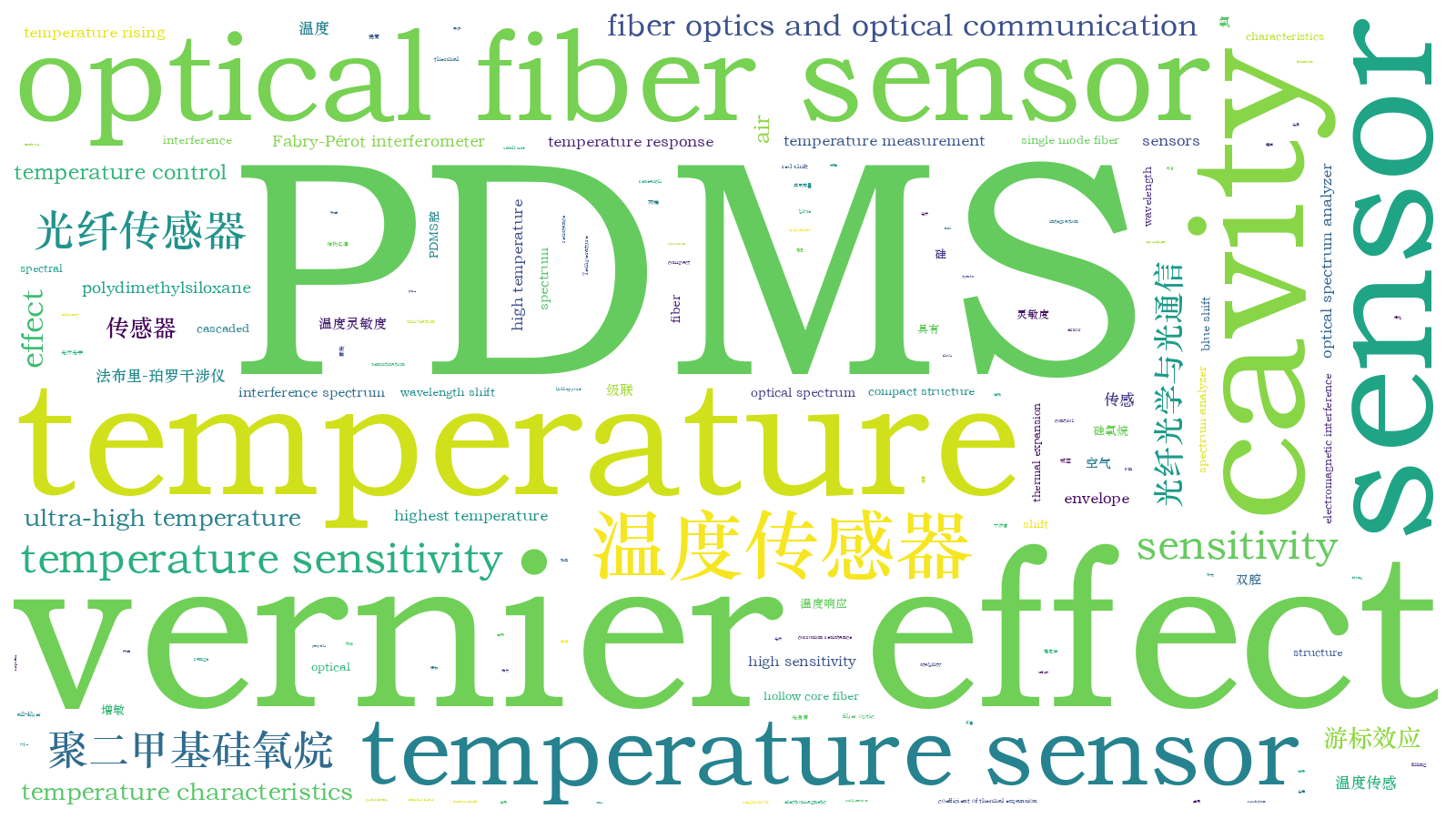基于聚二甲基硅氧烷增敏的级联双腔温度传感器
Temperature is the most basic and important physical quantity in scientific research and industrial production, so temperature measurement with high sensitivity is essential. Due to the advantages of corrosion resistance, high safety, electromagnetic interference resistance, small size, compact structure, and easy integration, the fiber optic Fabry-Pérot interferometer (FPI) sensor has widely drawn the attention of global scholars. However, the sensitivity of the all-fiber FPI temperature sensor is only 84.6 pm/℃ due to the low thermal expansion and thermal-optical coefficient of the quartz fiber. There are two effective ways to increase the sensitivity of FPIs. One is to use polydimethylsiloxane (PDMS) which has a high coefficient of thermal expansion, and the other is to generate vernier effect. The effective combination of PDMS and vernier effect will further improve the sensitivity of FPIs. In this study, a temperature sensor based on PDMS and vernier effect is proposed and fabricated. With the help of PDMS expansion and vernier effect, the sensor has excellent temperature characteristics.
In this study, a cascaded double-cavity temperature sensor based on PDMS sensitization is proposed, which is composed of a PDMS cavity and an air cavity in cascade (Fig. 1). The PDMS cavity is formed by filling PDMS into a section of hollow core fiber with one end fused with the single mode fiber (SMF). The air cavity is formed by filling the PDMS cavity into a tube with a section of PDMS. The optical paths of PDMS cavity and air cavity are close but not equal, so the vernier effect is generated, and an envelope appears in the spectrum. The two cavities have opposite temperature responses, so the sensitivity of the sensor can be greatly improved by vernier effect. When the temperature increases, the length of the air cavity changes greatly due to the expansion of the PDMS at both ends, which greatly improves the temperature response of the air cavity and results in a further increase in the sensitivity of the sensor. Under the dual action of PDMS and vernier effect, the sensor has excellent temperature characteristics.
The temperature performance of the sensor are theoretically analyzed and simulated. In the simulation, the free spectral ranges (FSRs) of PDMS cavity and air cavity are 5.20 nm and 4.40 nm, respectively, and the obtained spectrum envelope of the cascaded structure is 32.20 nm (Fig. 2). When the temperature rises from 40 to 41 ℃, the PDMS cavity has a red shift of 0.9 nm, and the air cavity has a blue shift of 2.6 nm, while the spectral envelope has a blue shift of 24.8 nm, which is 27.6 times as much as that of single PDMS cavity and 9.5 times as much as that of the single air cavity. In the experiment, the sensor is put into a temperature control box, and its interference spectrum is measured by an optical spectrum analyzer (Fig. 6). There is an obvious envelope with the FSR of 32.9 nm in the interference spectrum of the sensor (Fig. 7), which shows that vernier effect is generated. When the temperature increases, the spectral envelope shifts gradually to a short wavelength (Fig. 7). The temperature rising and falling experiments are carried out to investigate the stability and repeatability of the sensor, and the peak wavelength of the envelope is recorded at every interval of 0.2 ℃. By linearly fitting the data of wavelength shift versus temperature in the range from 40 to 42 ℃, the sensitivities of -21.10, -20.25, -20.88, and -19.96 nm/℃ are obtained (Fig. 9), and the average sensitivity is calculated to be about -20.55 nm/℃, which is 37 times as much as that of a single PDMS cavity (0.56 nm/℃). The maximum error between the sensitivities is about 5%, and the error is mainly caused by the low resolution of the temperature control box. In addition, the sensitivity of the sensor is slightly lower than the simulation results (-24.8 nm/℃). The reason is that the PDMS in the sensor is not freely expanded, and its actual expansion is smaller than that in ideal conditions. Compared with other FPI sensors based on PDMS, the proposed sensor has the highest temperature sensitivity (Table 1).
A cascaded double-cavity temperature sensor based on PDMS sensitization is proposed and prepared, which is composed of a PDMS cavity and an air cavity. The optical paths of the two cavities are similar but not equal, and the two cavities have opposite temperature responses, so the enhanced vernier effect is generated, and an envelope appears in the interference spectrum. In addition, the sensitivity of the sensor is further improved by the expansion of the PDMS at both ends of the air cavity. Under the dual effect of PDMS and enhanced vernier effect, the sensor has an ultra-high temperature sensitivity. The experimental results show that the temperature sensitivity of the sensor is about -20.55 nm/℃ in the range of 40-42 ℃, which is about 37 times as much as that of the single PDMS cavity. With the help of PDMS and vernier effect, the sensor has excellent temperature characteristics. Due to the advantages of electromagnetic immunity, compact structure, high sensitivity, excellent stability, and easy integration, the sensor is promising for applications in scientific research and industrial production.
杨玉强, 高佳乐, 牟小光, 王骥, 杨文虎, 李依潼, 王楚虹. 基于聚二甲基硅氧烷增敏的级联双腔温度传感器[J]. 光学学报, 2023, 43(19): 1906001. Yuqiang Yang, Jiale Gao, Xiaoguang Mu, Ji Wang, Wenhu Yang, Yitong Li, Chuhong Wang. Cascaded Double-Cavity Temperature Sensor Sensitized by Polydimethylsiloxane[J]. Acta Optica Sinica, 2023, 43(19): 1906001.







